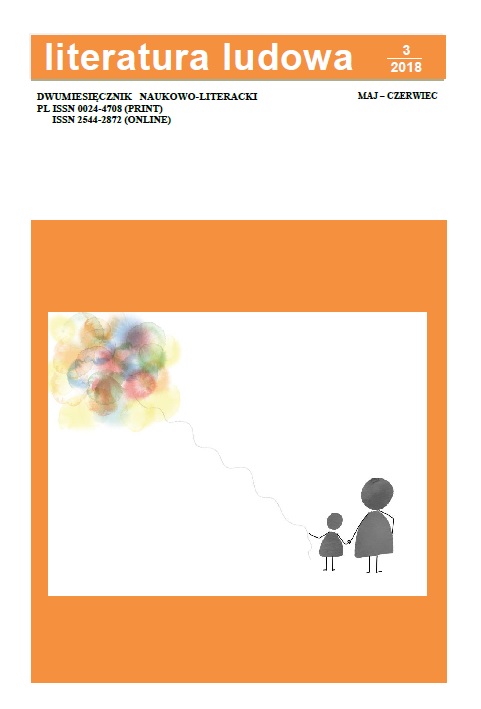Confession and Camouflage: Biographical Memory in Visual Narratives by Peter Sis, Uri Orlev and Marta Ignerska
DOI:
https://doi.org/10.12775/LL.3.2018.001Keywords
biographical memory, camouflage, child and adult self, confession, convergence, intergenerational connectivity, ironyAbstract
In my article, I argue that Peter Sis’ Tibet Through the Red Box (1998) and the Polish edition of Uri Orlev's Granny Knits (first published in Hebrew in 1981) illustrated by Marta Ignerska (2009) represent two different forms of intergenerational remembering. The visual narratives in question are artistic portrayals of the narrators’ biographical memory, and in some sense it is possible to view both works as narratives in which intergenerational connectivity is an integral aspect of the story. However, in each book the symbolic return to childhood has a different character. In Orlev and Ignerska's book, the rigidly delineated categories of “childhood” and “adulthood” are not really applicable, as they merge on every possible level – in their formal, expressive, and philosophical aspects. In Sis’ narrative, the (visual) language may resemble conventions associated with children's literature, but it is primarily an element of the book's nostalgic message, not a signal of the narrator's authentic and permanent connection with his child self.
References
ANTONISZCZAK, J. (1971). Jak działa jamniczek. Warszawa/Kraków: Studio Miniatur Filmowych.
ANTONISZCZAK, S. (2010). Jak działa jamniczek? 2+3D (quarterly), 19.08. Obtained from http://www.2plus3d.pl/artykuly/jak-dziala-jamniczek.
BAUMAN, Z. (1991). Modernity and the Holocaust. Cambridge: Polity Press.
BEAUVAIS, C. (2017). Next of Kin: “The Child” and “The Adult” in Children's Literature Theory Today and Tomorrow. In: M. Nikolajeva and C. Beauvais (eds.), The Edinburgh Companion to Children's Literature (pp. 265-273). Edinburgh University Press.
GITTINS, D. (2009). The historical construction of childhood. In: M. J. Kehily (ed.), An Introduction to Childhood Studies: Second Edition (pp. 35-49). Open University Press.
HEMMINGS, R. (2007). A Taste of Nostalgia: Children's Books from the Golden Age – Carroll, Grahame, and Milne. “Children's Literature”, Vol. 35 (pp. 54-79).
KAŹMIERSKA, K. (2008). Biografia i pamięć. Na przykładzie pokoleniowego doświadczenia ocalonych z Zagłady. Kraków: Nomos. (Biography and Memory: The Generational Experience of the Shoah Survivors (2012). Trans. K. Maciejczyk. Academic Studies Press).
NATOV, R. (2018). The Courage to Imagine: The Child Hero in Children's Literature. London: Bloomsbury.
NODELMAN, P. (2008). The Hidden Adult: Defining Children's Literature. Baltimore: The John Hopkins University Press.
NUSSBAUM, Martha, C. ((1986) 2001). The Fragility of Goodness: Luck and Ethics in Greek Tragedy and Philosophy (updated edition). Cambridge University Press.
OMMUNDSEN, Å. M. (2015). Who Are These Picturebooks For? Controversial Picturebooks and the Question of Audience In. J. Evans (ed.), Challenging and Controversial Picturebooks: Creative and Critical Responses to Visual Texts (pp. 71-93). London & New York: Routledge.
ORLEV, U., and M. Ignerska (2009). Babcia robi na drutach (Granny Knits) (1980). Wytwórnia.
ORLEV, U. (1999). Granny Knits. Trans. Eddy Lewinstein. Illus: Ora Eitan. New Dehli: National Book Trust, India.
ORLEV, U. (2012). Książki mojego dzieciństwa (1931-1945). Lublin: UMCS.
ORLEV, U. Izraelski pisarz Uri Orlev: Jestem polskim patriotą. Interview. Polskie Radio Jedynka. Obtained from https://www.polskieradio.pl/7/178/Artykul/1083767,Izraelski-pisarz-Uri-Orlev-jestem-polskim-patriota.
ORLEV, U. (2011). Najlepsze czasy były w getcie. Wywiad z P. Smoleński. „Gazeta Wyborcza. Duży Format”, 30.06.
ORLEV, U. (2011). Nie mogę znaleźć w sobie nienawiści. Wywiad z A. Zagner. „Polityka” (weekly). 04.07. Obtained from https://www.polityka.pl/tygodnikpolityka/spoleczenstwo/1517204,1,izraelski-pisarz-uri-orlev-dla-politykapl.read.
SIS, P. (1998). Tibet Through the Red Box. New York: Frances Foster Books.
SIS, P. (2007). The Wall: Growing Up Behind the Iron Curtain. New York: Frances Foster Books.
YOUNG, J. E. (1993). The Texture of Memory. Holocaust Memorials and Meaning. Yale University Press.
“MANDALA”. The Book of Symbols: Reflections on Archetypal Images (2010). Editor-in-chief: A. Ronnberg. Ed: K. Martin. Koln: Taschen.
WILLIAMS, A., and J. F. Nussbaum (2001). Intergenerational Communication Across the Life Span. Mahwah, NJ, London: Lawrence Erlbaum Associates.
WALLER, A. (2017). Re-memorying: A New Phenomenological Methodology in Children's Literature Studies. In: M. Nikolajeva and C. Beauvais (eds.), The Edinburgh Companion to Children's Literature (pp. 136-149). Edinburgh University Press.
WINCENCJUSZ-PATYNA, A. (2014). Nowe szaty (graficzne) książki (polskiej). „Znak” (monthly), September, nr 712. Obtained from http://www.miesiecznik.znak.com.pl/7122014anita-wincencjusz-patynanowe-szaty-graficzne-ksiazki-polskiej/.
AYAKA, C. and I. Hague (eds) (2014). Representing Multiculturalism in Comics and Graphic Novels. Routledge.
LA CAPRA, D. (2000). Writing History, Writing Trauma. John Hopkins University Press.
GIŻYCKI, M. (2000). Nie tylko Disney. Rzecz o filmie animowanym. Warszawa: Wydawnictwa Artystyczne i Filmowe. Wydawnictwo Naukowe PWN.
HOWORUS-CZAJKA, M. (2017). Gra ze sztuką w książce obrazkowej. In: M. Cackowska, H. Dymel-Trzebiatowska, and J. Szyłak (red.). Książka obrazkowa. Wprowadzenie (173-190). Poznań: Instytut Kultury Popularnej.
HOLLINDALE, P. (1997). Signs of Childness in Children's Books. Thimble Press.
OLSEN, S. (2015). Ed. Childhood, Youth and Emotions in Modern History: National, Colonial and Global Perspectives. Palgrave.
Downloads
Published
How to Cite
Issue
Section
License
1. The authors give the publisher (Polish Ethnological Society) non-exclusive license to use the work in the following fields:a) recording of a Work / subject of a related copyright;
b) reproduction (multiplication) Work / subject of a related copyright in print and digital technique (ebook, audiobook);
c) marketing of units of reproduced Work / subject of a related copyright;
d) introduction of Work / object of related copyright to computer memory;
e) dissemination of the work in an electronic version in the formula of open access under the Creative Commons license (CC BY - ND 3.0).
2. The authors give the publisher the license free of charge.
3. The use of the work by publisher in the above mentioned aspects is not limited in time, quantitatively nor territorially.
Stats
Number of views and downloads: 512
Number of citations: 0



